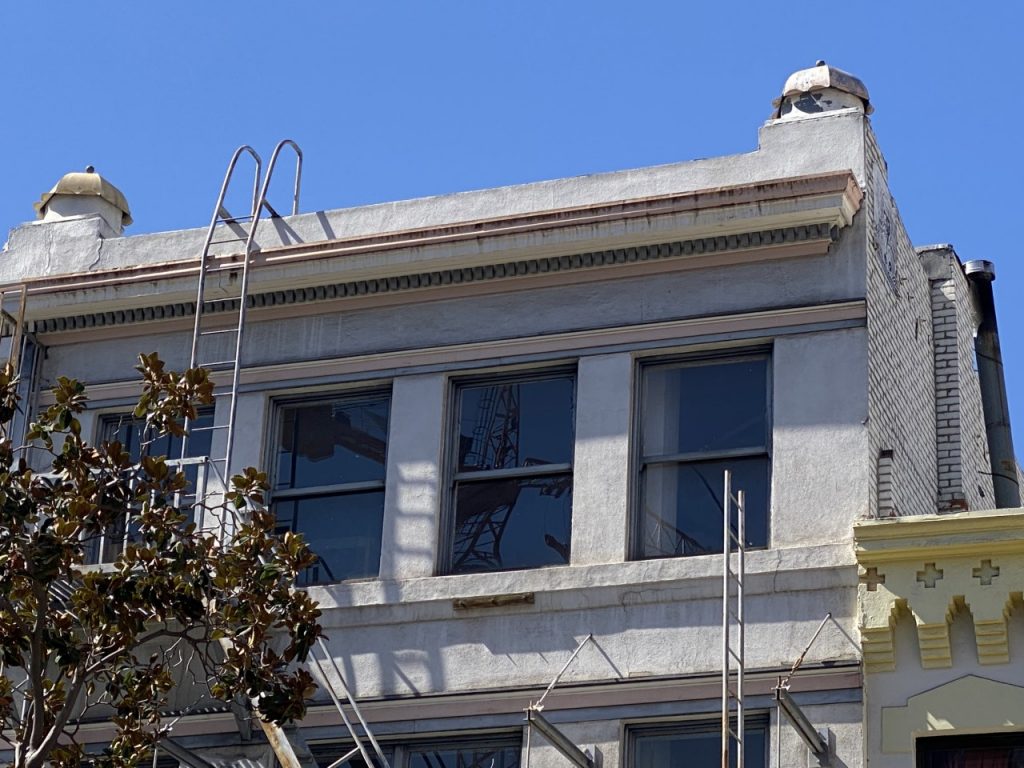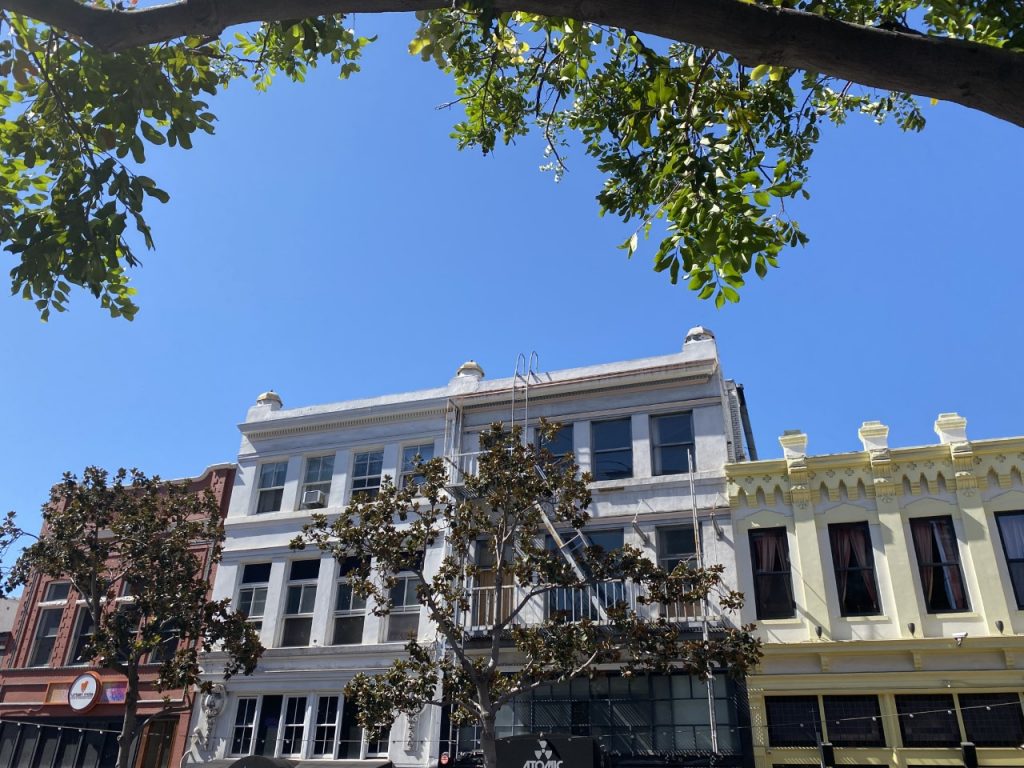No products in the cart.
Landmarks
So Many Books, So Little Time!
Loring and Company Building
1873, 1885 & 1908
764 Fifth Avenue
Architects: J. Kueppers & Edmond Blachman
Architectural Style: Victorian Commercial
In this age of streaming, Kindle and social media, fewer and fewer people are availing themselves of print literature. Gone are the days of curling up with a good book and a cup of tea. Fondly remembered, though, are the early 20th century libraries with their elegant facades and shelves and shelves of books, where an entire Saturday afternoon could be spent browsing and day dreaming. Some even met a date there!
In the golden era of serious reading, San Diego’s first book emporium was opened by Arnold Schneider in 1869. He sold the latest publications, stationary, musical instruments, paper collars, toys, spectacles, smoker’s supplies, artists’ materials and fine wallpaper. His large inventory, no doubt, needed a more spacious venue, so what is now known as the Loring building, was constructed in 1873. This makes it one of the oldest buildings in the Gaslamp. Mr. Schneider’s firm was now known as Schneider, Grierson and Company to reflect Mr. Schneider’s new partner, Robert C. Grierson.
During the excavation, under the supervision of Aleck Kitterman, gold was found in the gravel taken from the the cellar excavation. Mr. Kitterman was actually a restauranteur, and owner of the “United States” restaurant on Fifth St. down by the wharf. He stated that all meals were 25 cents, and “could be obtained at any hour.” Plus – he had sleeping rooms in the back! Apparently in over his head as far as excavation, he departed and turned the excavation over to Mr. M. Amling. Bayley Brothers casted the iron columns for the building, and the brickwork was done by H. Hemphill and Company. The architect, J. Kueppers, contracted the woodwork out to Thomas W. Merrell. The structure was originally a single story with basement, and the cost for the building was $6,500.
In late 1873, Mr. Grierson, who also served as Secretary of the San Diego Free Library Association , left the partnership, and was replaced by Mr. James Abegg. Schneider and Abegg continued the business as booksellers, stationers, and news dealers. and expanded their business inventory. According to the 1874 City Directory, the bookstore now included globes, mathematical and optical instruments, maps, gold scales, traveler’s utensils, compasses, games, chromos (color plate lithographs), picture frames, fancy goods and photographic views of San Diego and vicinity. Additionally, they were local agents for the San Diego Daily and Weekly Union and other leading papers.
In 1875, James Abegg withdrew from the firm, and was immediately replaced by Theodore Kueppers. Mr. Schneider added a second story to the building in 1885, with the additional story being utilized as art rooms and a gallery featuring exhibitions of paintings, engravings and photographs. A stunning redwood stairway handcrafted by local carpenter, Mr. Rost, led to the upper floor, where the walls and ceilings were covered in beautiful wallpaper. The exterior facade featured red and black brick designs and ornate Victorian woodwork. The additional space not only provided much needed space and convenience, but also presented a striking appearance to prospective customers.
After the 1885 building addition, Schneider sold the building and the business to Isaac Levi and Monroe Wertheimer, two young, energetic businessmen. Although they both had other business ventures in the area, they continued to run the bookstore successfully for several years.
In 1897, Arthur Loring, formerly of the Loring Book Store at the I.O.O.F. Building on Market Street, bought out his former partners, and along with his brother, Edmond, moved into the bookstore on 5th. They renamed it the Loring Brother’s Book Store. The business was incorporated as the Loring Brothers Book Store in 1903, and the capital stock was listed at $25,000! The newly minted corporation had five directors, all of them in the Loring family.
The third and final floor was added in 1908. Designed by Edmond Blochman, the architect of the adjoining Fritz Building, the third floor meshed perfectly with its adjoining neighbor, as it featured a continuation of the roof parapet and identical dentil moulding.

The now brick and stucco three-story building featured a flat roof with a parapet, decorative dentil moulding and finials on either end of the parapet.
In 1914, the Lorings sold their bookstore to three brothers – Wilbur, Daniel and Jerome Carpenter, who opened Carpenter’s Book Store at the same address. In 1920, the Carpenters moved out, and Louis Goldberg, a local retail merchant, leased the building and opened it as a retail clothing store. For the first time since its opening in 1873, the building was no longer a bookstore. It had a continuous run of 47 years! Mr. Goldberg operated his retail business well into the 1930s. It then became a loan office and ultimately became the home of Pacific Coast Loan and Jewelers, the Gold Club Gym and other retail enterprises.
This enduring little building was resurrected in 1989, as the Gaslamp was in the process of restoration and repurposing its old buildings. Noted architect and preservationist, Wayne Donaldson, designed the renovation of the Loring Building. The newly reborn structure featured high ceilings, exposed brick walls, and a skylight, plus a modern security system.
The Loring Building is now unoccupied. With bibliophiles throughout the city clamoring for a downtown bookstore, the site of so many successful bookstores would have provided the perfect scenario. But alas, it was not meant to be. The Loring is slated to become a supper club.
Sandee is the Historian & Lead Tour Guide for the Gaslamp Quarter Historical Foundation. She can be reached at [email protected].

